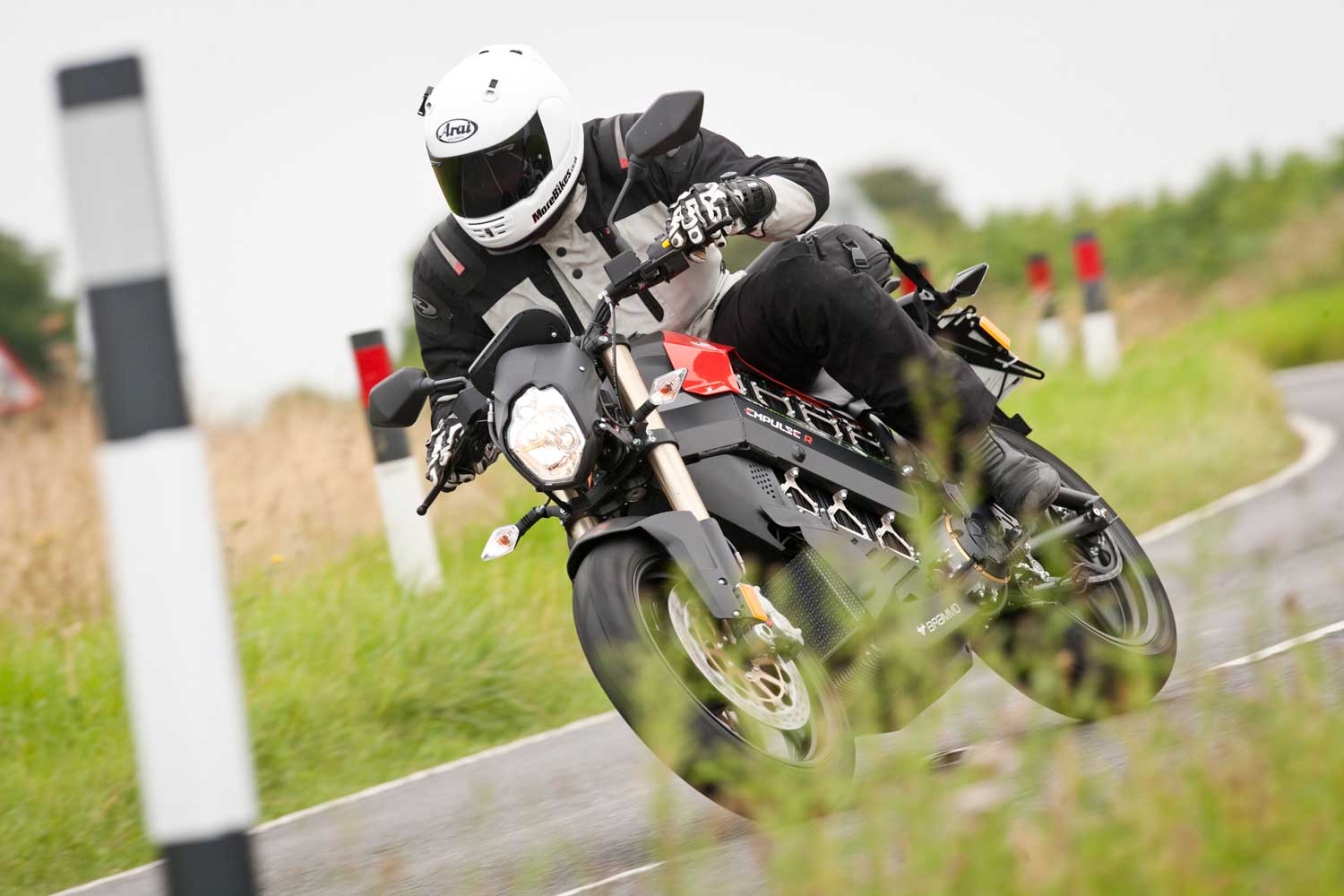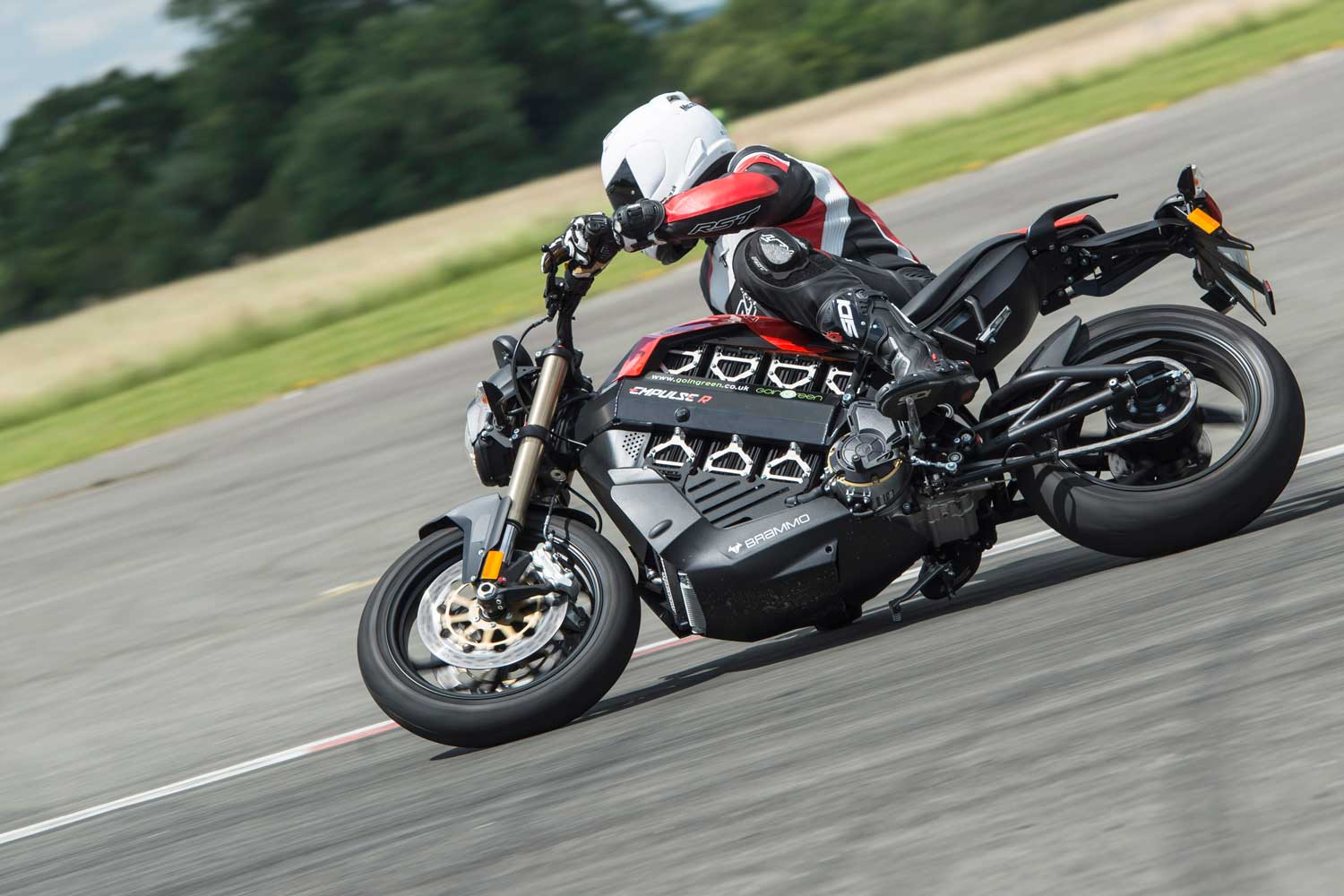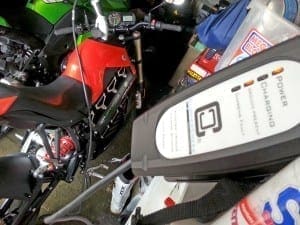 Editor John Milbank spent a few days with a Brammo Empulse R electric motorcycle to find out if it’s time to ditch the pump. Photos: Simon Hipperson
Editor John Milbank spent a few days with a Brammo Empulse R electric motorcycle to find out if it’s time to ditch the pump. Photos: Simon Hipperson
This bike probably isn’t for you. Chances are you enjoy a good thrash at the weekend, touring to far flung reaches of the globe, or racking up miles on a long commute. Read on though, as this is a technology that’s moving quickly, and if you happen to live in or around London (or any other congested city), and are looking for something that’s bloody good fun to ride, it might be time to give electric power a try.
Enjoy everything More Bikes by reading the MoreBikes monthly newspaper. Click here to subscribe, or Read FREE Online.
Give me the bad news first
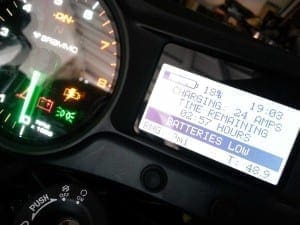 Range. With a claimed range of 80 combined miles (based on 128 miles in the city or 58 miles on the highway), you’re not going to be touring on this bike. Let’s assume you want to ride from London to Edinburgh. That’s 405 miles. With fuel stops on a normal bike you’d probably be looking at around seven hours, with a very numb bum. On the Brammo, assuming you get 58 miles out of a full charge, it would take about 31 hours, thanks to the need for seven full charges, each taking three and a half hours (though you’d be very rested by the time you got there).
Range. With a claimed range of 80 combined miles (based on 128 miles in the city or 58 miles on the highway), you’re not going to be touring on this bike. Let’s assume you want to ride from London to Edinburgh. That’s 405 miles. With fuel stops on a normal bike you’d probably be looking at around seven hours, with a very numb bum. On the Brammo, assuming you get 58 miles out of a full charge, it would take about 31 hours, thanks to the need for seven full charges, each taking three and a half hours (though you’d be very rested by the time you got there).
Time to recharge is the real issue with any electric vehicle. At the moment. While charging times on electric machines can vary, you’re still looking at hours rather than minutes. And if the charging points are all occupied, you’re stuck. At the moment.
A full charge would cost about £1.36 at home, which at 58 miles equates to around 2.5p per mile. If you’re after economy, a used Honda CG125 giving 100mpg would cost about 6p per mile. Of course, a used CG will cost you around £14,700 less than a new Empulse R, so you’d have to travel 420,000 electric miles before you broke even.
They’d be 420,000 very fun miles, because the Brammo handles beautifully, looks great, and is confidence inspiring and easy to ride. Use it where it’s intended – commuting in and around busy city centres – and you can ignore much of the above. Yes it’s expensive, but so are many ‘proper’ motorcycles. I own a 2000 CBR600 that cost me £1200 because it’s all I can afford. That doesn’t mean I wouldn’t buy a brand new Panigale if I had the money.
Let’s say you’ve got a well-paid job in the Isle of Dogs. You live in Sevenoaks, and you’re fed up with the one-hour rail commute. That 28mile journey could be a lot of fun on a bike, and you could charge it up while you’re at work. You wouldn’t pay any road tax, there’d be no congestion charge, and parking would be free. Boris says he wants to “Rapidly accelerate the uptake of electric vehicles, and make London the epicentre of electric driving in Europe”. If the capital’s roads are going to be jammed with silent cars, then a bike makes even more sense for nipping through town.
To read the track-test review of the Brammo Empulse R, and for for technical details, click here
What’s it like to live with?
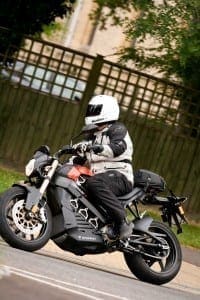 Goingreen.co.uk imports the Brammo, and was confident enough in the bike’s performance to loan me one for several days. I live in East Anglia, and have a 50 mile commute on fast open roads. Just what the Brammo isn’t meant for.
Goingreen.co.uk imports the Brammo, and was confident enough in the bike’s performance to loan me one for several days. I live in East Anglia, and have a 50 mile commute on fast open roads. Just what the Brammo isn’t meant for.
An overnight charge saw the bike silently start up with an indicated range of 120 miles, so I left home confident. I decided to make sure I stuck well within the speed limits, but by the time I was half way there I was worried – the charge capacity had dropped below 50%, and I found myself laying on the tank for aerodynamic efficiency, not exceeding 50mph. That used CG125 was looking more attractive by the mile.
I arrived with 4% battery, every warning light flashing, and an indicated range of just one mile. I wasn’t that excited about the trip back.
Deciding that I’d just use my breakdown cover on the way home, I rode the freshly charged Brammo at 60mph for the first 30 or so miles of the journey back. I didn’t bother overtaking many cars, but by the time I was about 15 miles from home, the battery was still doing fine, so I rode it like any other bike. I overtook when I could, I ‘made progress’ on the open stretches, and I got home with battery to spare.
 The regenerative system does work, and it proves that the electric bike really is happier speeding up and slowing down that it is sitting at one speed. What’s hard on a long journey is trusting that you’ll get to your destination, but experience would build confidence.
The regenerative system does work, and it proves that the electric bike really is happier speeding up and slowing down that it is sitting at one speed. What’s hard on a long journey is trusting that you’ll get to your destination, but experience would build confidence.
Taking the bike out for a photoshoot the next day saw the battery struggle – 10 miles of dual carriageway at 75mph swallowed about 25% of the juice, but a quick blast down the fast twisty route didn’t have as much impact. However, ten passes for the photographer saw 20 miles eaten up as I accelerated hard; rode fast; turned round in the road and repeated. With just 35miles on the clock, the range had dropped to six miles and the warning lights were flashing.
Riding through the city saw the range expand as my speed dropped, with far more stop-start riding and no hard acceleration. One hour plugged into a commercial charging point at the Marshall Toyota dealership while we took a lunch break boosted the charge by 28%, which was more than enough for the 8 miles of city riding, and 4 miles of dual-carriageway I had left to do.
Can I have fun on it with other bikes?
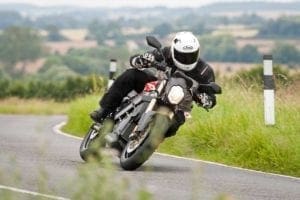 Yes. If you don’t go too far. Having been out for a good blast with my mates, which saw fast sweeping roads and tight bumpy tracks, I’d be confident in going out for a 40 mile ride. The quality Marzocchi forks and Sachs shock are firm enough for the surprising 213kg weight of the
Yes. If you don’t go too far. Having been out for a good blast with my mates, which saw fast sweeping roads and tight bumpy tracks, I’d be confident in going out for a 40 mile ride. The quality Marzocchi forks and Sachs shock are firm enough for the surprising 213kg weight of the
bike, but rides well over even harsh bumps. You can throw this small motorcycle about very easily, and while most petrol-powered machines will out-drag it on the straights (I found 0-6 times were around 5-6 seconds), you can fly past them on the brakes and fling it through the bends, confident in the motor’s smooth and linear power delivery. Things slow down after 85mph, and reaching 100 sees you flat on the tank as the numbers gradually increase.
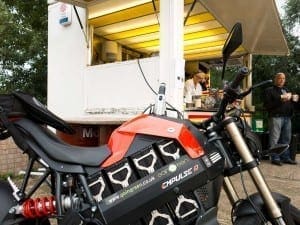 In town, the steering lock isn’t that tight, though I noticed that it’s adjustable with a pair of bolts, and a few more millimetres of movement would be possible without the forks hitting the frame.
In town, the steering lock isn’t that tight, though I noticed that it’s adjustable with a pair of bolts, and a few more millimetres of movement would be possible without the forks hitting the frame.
Unlike a used CG125, this is a bike that grabs attention. At the Iron Horse Ranch House in Market Deeping – a great restaurant that offers a warm welcome and a burger van in the car park on Thursday nights – there were a lot of Harley and custom owners, yet they were all interested in the Brammo. The first question was always “How far will it go”, closely followed by “How long’s it take to charge”. Despite having enough juice to get me home, they insisted I charge it from the burger van.
The general consensus was that it’s a great looking machine (though the swingarm’s styling came in for some critiscm), but they couldn’t get their heads around the lack of exhaust. Like most bikers, they’re open-minded to new ideas, and the conversation was soon steered towards Harley-Davidson’s new electric concept bike. Until their attention was lost when a noisy chopper rolled in.
Is this really the future?
The majority of bikers in the UK won’t be buying a Brammo, or any other electric bike, but they’d be small-minded to not admit the potential. Lithium battery technology means range is limited and charge times restrictively long. At the moment.
Researchers at the US National Renewable Energy Laboratory are experimenting with nanotubes – tiny tubes and rods that could lead to advances in cell performance, while to solve the problem of fast charging, Washington State University (WSU) has developed the first fuel cell that can directly convert gasoline to electricity. It has an anode, cathode and electrolyte – just like a battery – but uses fuel to provide a continuous flow of electricity. It could be four times more efficient than a combustion engine.
Dr. Su Ha is an associate professor in the Gene and Linda Voiland School of Chemical Engineering and Bioengineering at WSU: ” Our molybdenum dioxide (MoO2)-based solid oxide fuel cell (SOFC) generates electrical power by directly feeding liquid fuels like gasoline and diesel to the cell. Because fuel cells operate based on an electrochemical reaction, they offer much improved fuel efficiency compared to conventional combustion engines.
“In transportation there is a move towards a “More Electric” platform because electrical power is clean and safe if it is handled properly. The automobile industry has been implementing a “More Electric” platform steadily for new car designs to offer improved fuel mileage and address environmental concerns by reducing CO2 emissions. Currently, hybrid cars (combining the internal combustion engine with batteries) are available, but the inefficient internal combustion engine lowers the overall fuel efficiency. Fuel cells are more efficient at converting the chemical energy of fuels into electrical energy. Fully electric automobiles are limited by the high cost of lithium-ion batteries and their low capacity. Fuel cells have significantly higher energy densities than batteries. While several automobile manufacturers including Toyota and Honda have introduced fuel cell vehicles that are very expensive and can only operate on pure hydrogen. The lack of a hydrogen infrastructure and the challenges associated with storing hydrogen are again limiting factors for current fuel cell technology. Operating the fuel cell using existing liquid fuels, such as gasoline, means that the established fuelling infrastructure (i.e., gas stations) can be utilised.
“A hybrid car based on solid oxide fuel cells and batteries offers many exciting opportunities to lower fuel consumption and reduce polluting emissions. This hybrid system can take advantage of fuel cells that use high energy density liquid fuels for generating reliable electrical power over a long time at a constant load, while utilising the high power density of batteries to quickly respond to sudden changes in load, such as during rapid acceleration. The battery can be continuously charged by the fuel cell whenever the fuel cell produces more electrical energy than is required by the constant load condition. Thus, it offers a way of overcoming the currently long time required to charge depleted batteries.
“If a liquid fuel such as biodiesel derived from various biomass sources is used then the fuel cell-based hybrid system eliminates the need for fossil-based fuels such as gasoline.”

At the University of California, a lithium-ion battery has been created that is claimed to outperform current industry standards by three times. Using purified sand instead of graphite in the cell’s anode might mean we see a range of 150 miles between charges. We spoke exclusively to Zachary Favors, the graduate student who came up with the idea and is working with engineering professors Cengiz and Mihri Ozkan at the University of California, Riverside’s Bourns College of Engineering: “Electric vehicles is where batteries will truly shine in the world. Sure, the batteries in our cell phones and laptops will see the same boost in energy density, but the average consumer won’t experience that. This is because these devices become more and more powerful each year and therefore draw more on the battery. Electric vehicles is where we will witness the power of the next generation of batteries, because the main job (by a large margin) of those batteries is to simply propel the car.
“In the next five years batteries will see marked increases in energy density and lower costs, something that my sand-based technology definitely seeks to achieve and something that needs to happen in order for the average consumer to take interest in electric vehicles. I do not see some sort of giant leap happening in the battery world just yet, but rather a strong upward trend in performance and a gradual decrease in cost from year to year. We have to keep in mind that my sand-based anode only solves half the battery equation. We still need an energy dense material that operates on the positive [cathode] side of the battery to match it.
“One of the major hindrances for electric vehicles is simply the cost. This relatively high cost is due to the fact that large battery banks are needed to power electric vehicles and expensive systems are needed to control them. In designing new lower cost materials that can store more energy, we will see electric vehicles that can achieve the same range as internal combustion engine vehicles.”
Running out of petrol is a pain for all of us, but running out of petrol on a global scale is why scientists around the world are looking for solutions. Whether it’s electricity that powers the vehicles of the future, hydrogen, or something we don’t yet know about, all that matters to me is that there are companies out there eager to ensure the technology finds its way into motorcycles.
At the moment, bikes like the Brammo R are restricted to the lucky few whose circumstances allow them to make practical use of the machine. I know if I was that guy living in Sevenoaks, I’d be contacting goingreen for a test ride.
To read the track-test review of the Brammo Empulse R, and for for technical details, click here

